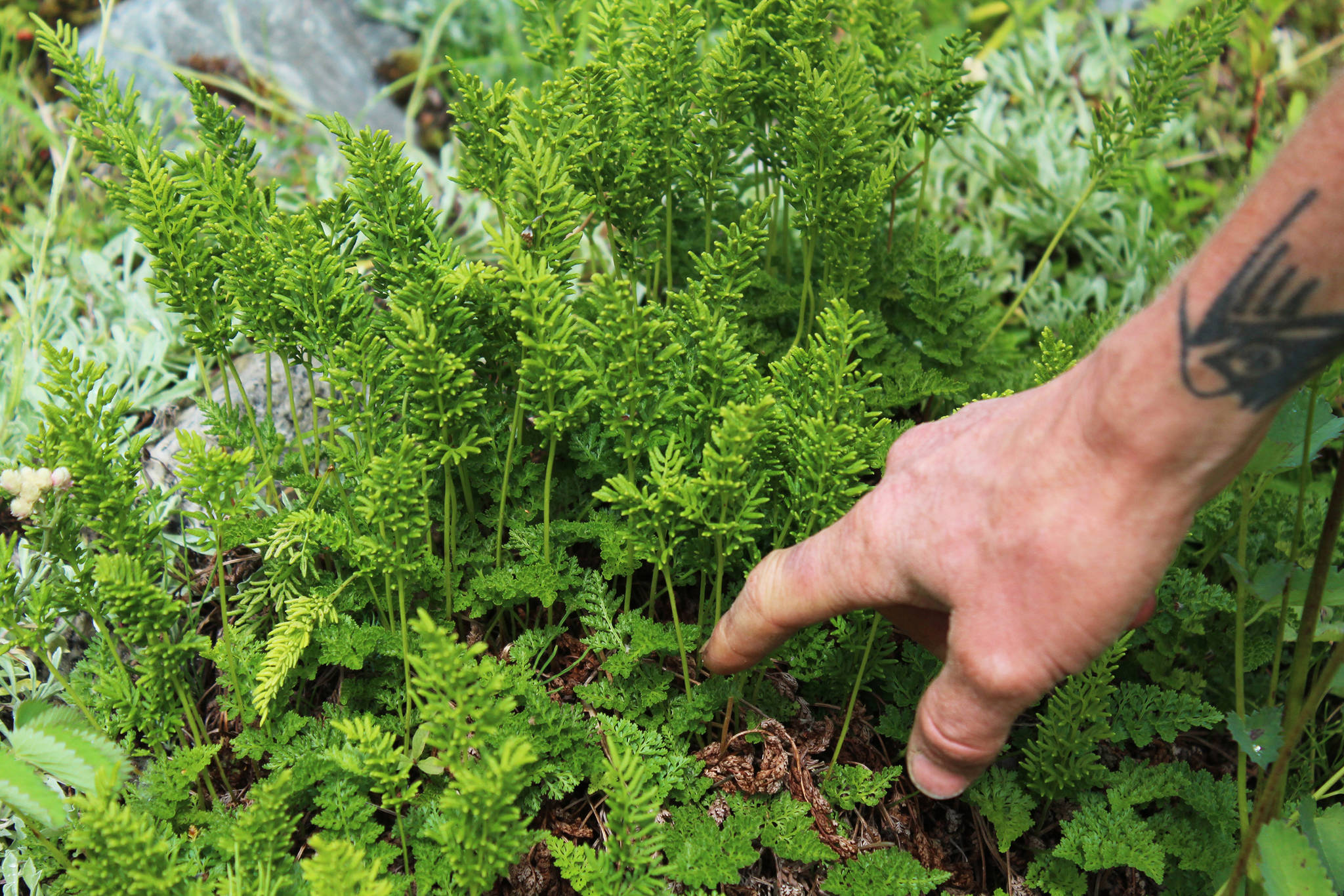Yarrow Hinnant has long known the many health and subsistence benefits native plants can provide. As the Pratt Museum’s new official gardener, he’s excited to bring that knowledge to Homer.
A native of North Carolina, Hinnant started the job in April. Before this, he spent about a decade between Oregon and Washington. During summer seasons, he would travel up to the Denali area to work for the National Park Service.
Throughout that time, Hinnant said he was on the hunt for property where he and his partner could start a farm. Their luck wasn’t great in the Lower 48 — what they found was either too expensive or not intact enough, he said. Alaska kept popping back into Hinnant’s mind.
“I’ve kind of been circling around and trying to get to where I can have a permanent base, and that’s finally here,” he said.
He remembered visiting Homer and liking it. He’s now been here for two years.
“(Homer) also is a place where you can actually farm,” Hinnant said. “As cool as right around the national parks are, there’s neither the population to support that kind of work, and the climate of course is much more difficult to deal with too.”
The position of the Pratt gardener is seasonal. Some hold it for a summer, while others have returned year after year to look after the botanical garden that sprawls in front of the building on Bartlett Street. Hinnant said he was attracted to the job in part because it would allow him the flexibility to continue working on numerous at-home projects.
“I really wanted to keep working outdoors and with plants,” he said. “That’s what I’ve been doing for a long time.”
Hinnant worked for years on backcountry trails, which entailed living out in the remote lands.
“I’ve always, since I was a child, been interested in plants,” he said. “Mostly things I could eat.”
As he grew older, Hinnant said he moved on to focus on the subsistence and medicinal aspects of plants in his life and work. He got into ethnobotany — the study of the traditional knowledge and customs native people had when it came to plants — and medicinal herbalism.
“Things you can actually forage for and use in a really consistent way,” he said.
He’s been able to pair this with a general interest in playing with different types of soil and gardening.
Hinnant gave credit to all the Pratt gardeners who have come before him.
“In a lot of ways I’m just stepping in and picking up a lot of the work that they’ve already put into this place,” he said.
One of the ways in which Hinnant is stepping in is by spearheading a redesign of garden signage. In the past, the plants have been marked with small metal signs that bore their names, he said. The new signs are being designed to be larger and to include botanical line drawings so visitors can tell whether the name actually matches the plant they’re looking at.
The new signs will bear each plant’s common name, Latin name, Dena’ina name and Aleut name, “reflecting that this isn’t just a museum project; this is a history that goes back a long time in this reason,” Hinnant said.
Some signs, where applicable, will include information about a plant’s medicinal use, whether it’s edible, or whether it’s poisonous.
This focus on modern uses for native plants is something Hinnant views as important and fitting with the community he works in.
“I think in Alaska there’s a lot more interest in foraging and native plant uses, and in general subsistence practices, than there area in most other places,” he said. “So I think fostering that and moving that forward is something that is important.”
Even if people don’t use medicinal and edible plant knowledge in their day-to-day lives, Hinnant said, his experience is that they show an interest in it. This is especially true of children who, like himself at a young age, are eager to know the boundaries of the plant life around them.
“When they visit the garden, some of the first questions they’re asking (are) ‘can I eat that?’ (and) ‘what is this one used for?’” Hinnant said. “And if you start opening that door, a lot of them become really interested in it.”
In addition to the changing signage, the museum will be renovating some of its front approaches to the building. This will disturb some areas of the garden. Hinnant said he and volunteers will transplant some of the more rare or sensitive plants ahead of this project to protect them.
“But that kind of gives us an opportunity to redesign some of it,” he said. “So I’m really interested in that project.”
Not only will he get to re-craft the space the sensitive plants can live in, Hinnant will get the opportunity to reevaluate the habitat sections the garden is organized by.
“It’s been a lot of years since that’s really been maintained meticulously,” he said.
While the garden had been constructed to mirror habitats like a bog as close as possible, the front of the Pratt isn’t really a bog, Hinnant said, just like it’s also not an alpine climate. Several vigorous plants have drifted over into other habitats over the years, he said, and many plants aren’t growing the way they would in their true habitat.
One of Hinnant’s hopes is to get the garden back to the level it was when it was first created. Some of the feedback he’s received is that the community would like it if the garden were on par with the botanical garden in Anchorage — one that visitors travel to see.
Those interested in helping out with the garden or learning more about volunteer opportunities can head to the Pratt any time between 11 a.m. and 4 p.m. on Thursdays.
Reach Megan Pacer at mpacer@homernews.com.

